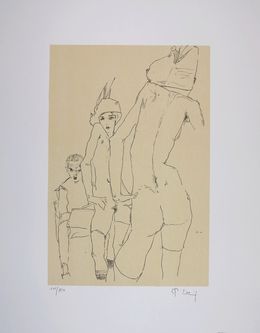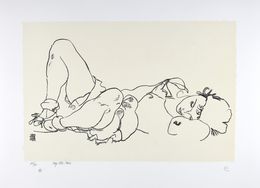


La Mère et l'Enfant / The Mother & the Child (Edith Schiele and nephew / Edith Schiele und Neffe / Edith Schiele et son neveu) - 1915
Egon Schiele
Print - 76 x 54 cm Print - 29.9 x 21.3 inch
$870

Nu au Miroir / A Nude Model Before a Mirror - 1910
Egon Schiele
Print - 58 x 45 cm Print - 22.8 x 17.7 inch
$800

Portrait de Gerti / Portrait of Gerti Schiele (Gerti Schiele in a Plaid Garment) - 1909
Egon Schiele
Print - 90 x 45 cm Print - 35.4 x 17.7 inch
$5,219

La Mère & la Fille / Mother and Daughter - 1913
Egon Schiele
Print - 80 x 58 cm Print - 31.5 x 22.8 inch
$2,552

Couple Enlacé / Couple Embracing - 1911
Egon Schiele
Print - 65 x 50 cm Print - 25.6 x 19.7 inch
$1,102

L'envol / The flight, 1917 (Mutter mit kind / Mother and child)
Egon Schiele
Print - 50 x 68 cm Print - 19.7 x 26.8 inch
$905

La fille au turban bleu, 1912 / The girl with blue headband, 1912
Egon Schiele
Print - 75.5 x 53 cm Print - 29.7 x 20.9 inch
$1,032

Couple Endormi, 1909 | Sleeping Couple, 1909
Egon Schiele
Print - 50.5 x 47 x 1 cm Print - 19.9 x 18.5 x 0.4 inch
$754

La fille aux cheveux longs, 1918
Egon Schiele
Print - 47 x 64 x 1 cm Print - 18.5 x 25.2 x 0.4 inch
$673

La femme allongée, 1918 | Reclining woman, 1918 (Liegende)
Egon Schiele
Print - 47 x 64 x 1 cm Print - 18.5 x 25.2 x 0.4 inch
$655

Lovers, 1917 (Mann und frau, umarmung)
Egon Schiele
Print - 74.5 x 52 cm Print - 29.3 x 20.5 inch
$1,148

La fille aux bas noirs et jarretières rouges, 1913 | The girl with red garters, 1913
Egon Schiele
Print - 70 x 50 cm Print - 27.6 x 19.7 inch
$870

L'Homme aux cheveux noirs, 1909 | Black-Haired Man, 1909
Egon Schiele
Print - 56 x 54 x 1 cm Print - 22 x 21.3 x 0.4 inch
$800

La Fille en rouge / The Girl in Red, 1913 (Standing woman in red / Stehende Frau in Rot)
Egon Schiele
Print - 70 x 50 x 1 cm Print - 27.6 x 19.7 x 0.4 inch
$754


Portrait de Edith Schiele / Portrait of Edith Schiele, 1915
Egon Schiele
Print - 65 x 50 cm Print - 25.6 x 19.7 inch
Sold
Art cannot be modern. Art is primordially eternal.
Biography
Egon Schiele was born in 1890 in the small Lower Austrian town of Tulln to a middle-class family of civil servants. He was raised alongside his two sisters, Melanie (1886–1974) and Gertrude (1894–1981).
Even as a young schoolboy, Schiele sketched prolifically. While attending high school in Klosterneuburg, the painter Max Kahrer became one of his first mentors and taught him various artistic techniques. Due to Schiele's poor academic performance, his mother decided to take him out of school early. His drawing skills eventually led him to pursue a career as an artist.
In October 1906, almost two years after his father's death, Schiele passed the entrance exam for the Fine Arts Academy of Vienna, where he was taught by Christian Griepenkerl, a painter known for his renderings of historical events.
In 1909 Schiele participated in the Internationale Kunstschau (International Art Show), which featured a tribute to Gustav Klimt and where Oskar Kokoschka made his debut. At the time, Schiele's work was still influenced by Klimt and the Viennese Jugendstil.
Openly rejecting the principles touted by his professor, Schiele teamed up with several classmates and other likeminded individuals to found the Neukunstgruppe (New Art Group) and dropped out of the academy in 1909. It was at the group's first exhibition that Schiele met the influential art critic Arthur Roessler.
The shift toward Expressionism occurred in 1910. With his new Expressionist color palette, Schiele was rebelling against both naturalism and the dominant Viennese Jugendstil, and new motifs - erotic nudes, watercolour drawings, pregnant women and, above all, self-portraits-burst into his work with tremendous gusto.
In 1911 Schiele met Walburga "Wally" Neuzil, who remained his favorite model and companion until the artist married Edith Harms in 1915.
His artistic career was suddenly interrupted in April 1912, when he was jailed on charges of pedophilia and kidnapping. The accusations turned out to be groundless, but Schiele still had to spend 24 days behind bars, a traumatic experience that inspired his famous prison series. In June 1915, one year after the outbreak of World War I, Schiele was stationed in Prague following a second draft. That same month he married Edith Harms, the daughter of a well-to-do family.
Starting in late 1915, his Expressionist art gradually gave way to a closer affinity with nature, which is particularly apparent in his increasingly realistic female nudes and portraits. After Gustav Klimt's sudden death at the beginning of 1918, Egon Schiele was widely regarded as his legitimate heir on the Viennese art scene.
Financial success came in March 1918 with the 49th Exhibition of the Vienna Secession: the artist received lucrative portrait commissions and the demand for his erotic nudes also rose.
A few days before the end of the war, on October 28, 1918, Schiele's pregnant wife Edith was struck down by a devastating Spanish flu epidemic. Three days later, Egon Schiele died of the same disease.
Nationality
Categories
Artistic movements
Themes









